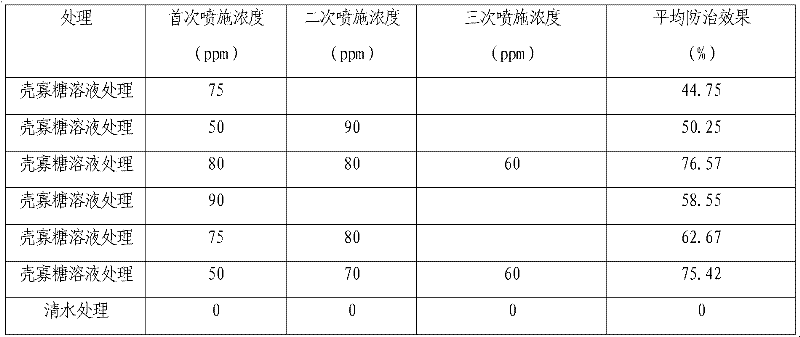Chitosan oligosaccharide composition for killing diamond back moths, its application and method
A technology of chitosan oligosaccharides and diamondback moth, which is applied in the field of agricultural chemistry to achieve the effect of no pesticide residue and improved effect
- Summary
- Abstract
- Description
- Claims
- Application Information
AI Technical Summary
Problems solved by technology
Method used
Image
Examples
Embodiment 1
[0021] Dilute the 5% chitosan oligosaccharide solution with water to the corresponding application concentration. The concentration is calculated according to the weight percentage concentration. In the result record, it is calculated as ppm (parts per million) concentration. In the result record below, 50 ppm means weight percentage The concentration is 0.005%. Clean water treatment was used as a control. The diluted solution was used to process the cabbage in the early onset of the diamondback moth in stages according to requirements, and the interval of spray treatment was 7 days. Each treatment was observed and detected through 3 test fields (100 square meters), and the disease development of the diamondback moth in each test field was counted separately. The timing of applying the chitosan oligosaccharide solution to the diamondback moth is that the diamondback moth eats the cabbage. The number of plants with insect populations accounts for 3±0.25% of the total cabbage pl...
PUM
 Login to View More
Login to View More Abstract
Description
Claims
Application Information
 Login to View More
Login to View More - R&D
- Intellectual Property
- Life Sciences
- Materials
- Tech Scout
- Unparalleled Data Quality
- Higher Quality Content
- 60% Fewer Hallucinations
Browse by: Latest US Patents, China's latest patents, Technical Efficacy Thesaurus, Application Domain, Technology Topic, Popular Technical Reports.
© 2025 PatSnap. All rights reserved.Legal|Privacy policy|Modern Slavery Act Transparency Statement|Sitemap|About US| Contact US: help@patsnap.com

